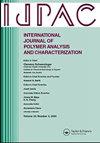静电纺聚乙烯醇和还原氧化石墨烯纳米纤维结构的物理和生物学特性
IF 1.7
4区 工程技术
Q4 POLYMER SCIENCE
International Journal of Polymer Analysis and Characterization
Pub Date : 2025-01-02
DOI:10.1080/1023666X.2024.2424264
引用次数: 0
摘要
由于石墨烯具有优异的物理性能和增强各种聚合物材料性能的能力,石墨烯基纳米复合材料的制造一直是人们越来越感兴趣的话题。评估这些纳米复合材料的生物相容性对于确保其在生物医学应用中的安全有效使用至关重要。本研究通过对电纺丝聚乙烯醇(PVA)/还原氧化石墨烯rGO纤维结构的物理和生物特性进行全面评估,表征并评估了其生物相容性。接触角测量结果表明,在静电纺PVA纤维中加入还原氧化石墨烯增强了纤维的表面润湿性,改善了纤维结构对PBS的吸收能力和降解性能。加入还原氧化石墨烯含量导致更高的水蒸气透过率,PVA + 0.5 wt达到~ 48 g/m2·天。% rGO和~ 45 g/m2·天的PVA + 1.0 wt。% rGO,而静电纺PVA纤维为~ 40 g/m2·天。细胞培养研究,包括MTT试验、碱性磷酸酶(ALP)活性分析、茜素红染色、荧光显微镜和扫描电镜分析,表明静电纺PVA + 1.0 wt。与其他样品相比,由于PVA + 1.0 wt的物理性能得到改善,rGO纳米复合材料表现出更好的细胞活力、增殖和生长。纤维结构。本文章由计算机程序翻译,如有差异,请以英文原文为准。
Physical and biological characteristics of electrospun poly (vinyl alcohol) and reduced graphene oxide nanofibrous structure
The fabrication of graphene-based nanocomposites has been a topic of increasing interest due to graphene’s exceptional physical properties and the ability to enhance the properties of various polymeric materials. Evaluating the biocompatibility of these nanocomposites is crucial to ensure their safe and effective use in biomedical applications. This study characterized and assessed the biocompatibility of previously fabricated electrospun polyvinyl alcohol (PVA)/reduced graphene oxide rGO fibrous structures by conducting a comprehensive assessment of their physical and biological characteristics. Contact angle measurements revealed that adding rGO to electrospun PVA fibers enhanced the surface wettability, improving the fibrous structure’s PBS absorption capacity and degradation behavior. Including the rGO content resulted in a higher water vapor transmission rate, reaching ∼48 g/m2·day for PVA + 0.5 wt.% rGO and ∼45 g/m2·day for PVA + 1.0 wt.% rGO, compared to ∼40 g/m2·day for electrospun PVA fibers. Cell culture studies, including MTT assay, alkaline phosphatase (ALP) activity analysis, alizarin red staining, fluorescence microscopy, and SEM analyses, demonstrated that electrospun PVA + 1.0 wt.% rGO nanocomposites exhibited superior cell viability, proliferation, and growth compared to other samples, due to the improved physical properties of the PVA + 1.0 wt.% rGO fibrous structure.
求助全文
通过发布文献求助,成功后即可免费获取论文全文。
去求助
来源期刊
CiteScore
3.50
自引率
5.30%
发文量
37
审稿时长
1.6 months
期刊介绍:
The scope of the journal is to publish original contributions and reviews on studies, methodologies, instrumentation, and applications involving the analysis and characterization of polymers and polymeric-based materials, including synthetic polymers, blends, composites, fibers, coatings, supramolecular structures, polysaccharides, and biopolymers. The Journal will accept papers and review articles on the following topics and research areas involving fundamental and applied studies of polymer analysis and characterization:
Characterization and analysis of new and existing polymers and polymeric-based materials.
Design and evaluation of analytical instrumentation and physical testing equipment.
Determination of molecular weight, size, conformation, branching, cross-linking, chemical structure, and sequence distribution.
Using separation, spectroscopic, and scattering techniques.
Surface characterization of polymeric materials.
Measurement of solution and bulk properties and behavior of polymers.
Studies involving structure-property-processing relationships, and polymer aging.
Analysis of oligomeric materials.
Analysis of polymer additives and decomposition products.

 求助内容:
求助内容: 应助结果提醒方式:
应助结果提醒方式:


